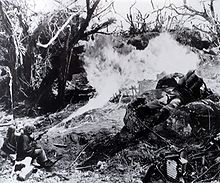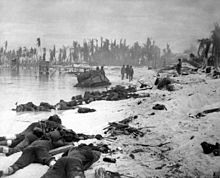Japanese fortifications on Tarawa
The fortifications on Tarawa were a strong ring of bunkers and other fortified positions built by the Japanese soldiers on the island of Betio as a system of defense against a landing by US forces . Betio is the main island with a port in the Tarawa Atoll, part of the Gilbert Islands , of great strategic importance because of its location in the central Pacific. For this reason, the US Pacific Command had formulated plans since 1942 to take the island and develop it into an important training and supply point from which material, troops and invasion fleets could be sent to other regions of the Pacific . The Japanese were aware of the strategic importance of the Gilbert Islands, especially after the successful American landing in the Battle of Guadalcanal , and therefore fortified the two most important points of the Gilbert Islands, the Tarawa and Makin Atolls .
Land defense
In September 1942, a convoy of ships arrived in Betio, carrying Rear Admiral Tomanari Saichirō ( 友 成 佐 市 郎 ), several thousand troops, material, ammunition, concrete and heavy cannons as well as armored turrets, gasoline, cars and trucks. Rear Admiral Tomanari had received orders to fortify the island ring around Betio in order to prevent an impending American landing. Rear Admiral Tomanari immediately built a large star-shaped airfield in the middle of the island. The Imperial Japanese Army then flew in 26 Mitsubishi A6M Zeros, which were supposed to be used for air defense. In addition, a ring of bunkers was built around the airfield to protect men and aircraft from air raids . These bunkers had no defense weapons, but numerous Flak - batteries covered. The Japanese troops then started the actual fortification work in November.
More than 500 heavy machine gun positions were built on the beaches , each dug deep into the sand and covered with a concrete or wooden roof and strewn with sand for protection and camouflage. These machine gun nests , often surrounded by barbed wire , were supposed to send a hail of bullets towards the US landing forces as soon as they jumped into the water. Gun emplacements were built behind the first line of defense, also dug deep into the sand and secured against bullets and bombs with concrete, iron plates and sandbags. Several hundred individual holes were dug between these two lines of fortification, camouflaged with palm leaves, which offered protection to snipers and small anti-tank guns , mostly 47 millimeters in caliber. The anti-tank weapons were supposed to inflict losses on American tanks and LVT swimming tanks (also known as "Amtracks") before they even reached the bank. The snipers, on the other hand, would target isolated Marines.
The transport ship Saida Maru was sunk about 200 meters from the beach . The bridge and deck protruded from the water. The Japanese built around 20 machine gun nests in the abandoned rooms of the bridge so that they could shoot at US troops swimming towards them, or to hit amphibious vehicles with bazookas .
Rear Admiral Tomanari had a palisade built from coconut palm trunks 6–7 m from the beach , which should stop any undamaged US vehicle.
Naval defense
Rear Admiral Tomanari also ordered an expansion of the sea obstacles.
The defense of the beach also relied on coils of barbed wire placed in the shallow water, as well as a mine ring, consisting of about 200 pieces, buried in the sand and connected by a fuse. Far off the coast, however, there were concrete obstacles, iron barriers and wire ropes equipped with mines that were only a few centimeters below the surface. As soon as a hull touched a rope, all the mines went up. There were over 1000 ropes stretched all over the lagoon. Artificial concrete shallows that the ships hit were also built. From the coast were 13 heavy coastal guns , including nine 14-cm guns and four from Singapore zoom housed, former British 20.3-cm howitzers of Vickers , monitor the sea. In addition, the Japanese had six 8 cm anti-aircraft guns and eight 7.5 cm field guns and ten 7.5 cm mountain guns available for direct defense near the coast .
"Yogaki Plan"
Rear Admiral Tomanari and Admiral Kondō Nobutake , the commander of the Second Fleet, which operated in the Central Pacific, formulated a plan to repel American forces at the moment of the invasion. The plan was sent to Tokyo on the evening of its completion , where it was read and approved by the Chief of Admiralty Staff Nagano Osami . The plan, which took the name Yogaki , which means "ambush attack", was as follows:
- The long-range bombers and fighter pilots would take off from Kavieng and Rabaul , two important Japanese bases in New Ireland , and fly into the newly built bases in the Marshall Islands , from where they would launch attacks against the US fleet.
- The Truk Atoll fighter pilots would also intervene.
- 25 submarines would be moved to the area of operations to attack the US fleet.
- Admiral Kondō's Second Fleet would leave Truk to take up action with the US fleet.
- The American landing forces that had landed on Betio would be forced to retreat by the defenders.
This plan was thwarted by the massive American air raids, because the Japanese bases of Kavieng and Rabaul suffered such heavy losses among their squadrons that it was impossible for them to send any reinforcements to the area of the Gilbert Islands. The Second Fleet had to leave Truk to avoid falling victim to the Allied bombers there, and did not make it to the Gilbert Islands in time. The submarines ran out anyway, but were attacked by destroyer groups. Only a few made it to the target area, and one of them sank the escort aircraft carrier USS Liscome Bay .
troops
2217 pioneers of the 111th Engineer Unit ( 第 111 設 営 隊 , dai-111 setsueitai ) and the 4th Fleet Engineer Detachement ( 第 4 艦隊 設 営 派遣 隊 , Dai-4 kantai setsuei hakentai ) were used to do this heavy work ; the former consisted largely of Koreans. In addition, there were 1479 soldiers of the 7th Sasebo Marine Special Infantry ( 佐世保 第 7 特別 陸 戦 隊 , Sasebo dai-7 tokubetsu rikusentai ) and 1122 soldiers of the 3rd special base defense ( 第 3 特別 根 拠 地 隊 , dai-3 tokubetsu ), and about konkyochit 400 men of the airfield.
Battle for Tarawa
The American troops landed on Betio on November 20 as part of the Battle of the Gilbert Islands , when Rear Admiral Tomanari had already been replaced by Rear Admiral Keiji Shibazaki . The landing of 14,000 Marines was preceded by violent air strikes , as well as a bombardment of the visible Japanese bunkers by the invasion fleet. This numbered over 200 ships, including 17 aircraft carriers , 12 battleships , 10 cruisers and 66 destroyers .
The defenses of the Japanese troops were almost insurmountable obstacles for the first Marines, claiming hundreds of victims before they could be eliminated with flamethrowers and hand grenades . Although they had recorded more than 2,000 dead and wounded by the first evening, the marines continued to make progress. The battle, for which the American planning staff had only planned 6 hours, lasted several days. It was the first operation in which the Marines had to storm serious defenses, and up to that point the heaviest and most expensive battle in the Pacific War .
On the evening of the fourth day, the last defenders were killed or had hand grenades and pistols that took life . Admiral Shibasaki died in the course of the battle, his 4000 soldiers were killed except for 17 wounded Japanese and 129 Korean workers. 1,000 American Marines were also killed over the four days.
Lessons from the Defense of Tarawa
The US generals who analyzed the enemy's defenses followed it over the next two years. The GIs and Marines were trained to eliminate bunkers , machine gun positions, and camouflaged snipers . During the next few years of the war, the experience of fighting on Tarawa helped conquer islands such as Saipan , Guam , Peleliu , Leyte , Iwo Jima and Okinawa .
literature
- Bernard Millot: The Pacific War . BUR, 1967
- Ugaki Matome : Fading Victory. The Diary of Admiral Matome Ugaki, 1941-1945. University of Pittsburgh Press, Pittsburgh 1991, ISBN 0-8229-5462-1 . New edition: Naval Institute Press, Annapolis 2008, ISBN 978-1-59114-324-6 (Editors: Katherine V. Dillon, Donald M. Goldstein, Gordon W. Prange. Translator: Masataka Chihaya).
- Paul S. Dull: A battle history of the Imperial Japanese Navy . Naval Institute Press, 2001





